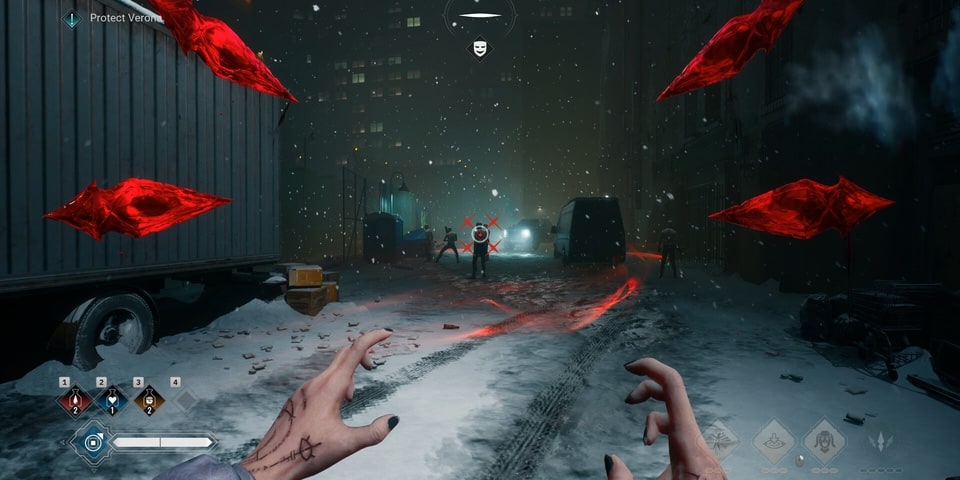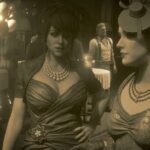The original Vampire: The Masquerade – Bloodlines is one of the best broken games you’ll ever play. I’m old enough to have been working in Game when it was released and it was one of the most refunded games I can remember, thanks to the retail release being utterly bug-ridden and borderline unplayable. Years later and after numerous fan patches and improvements, though, it’s been transformed into a masterpiece of Gothic RPG storytelling. The long wait for a sequel has been almost as uncomfortable as that original release, with a change of developer to The Chinese Room and many delays surrounding it, but the wait is finally over. Having spent 20 hours stalking the streets of Seattle, Vampire: The Masquerade – Bloodlines 2 is good, but the modern day smoothing down of rough gameplay edges has led to a more streamlined, but less unique game.
The first thing to consider here is the amount of roleplaying involved. You don’t get to create a character and there are no base stats to assign, instead only choosing your appearance and then later your clan. Levelling up is a linear process with each clan having 5 unique skills, though you can learn the skills of all the other clans as you progress, and inventory management is limited to several potions that can heal or replenish your blood meter (effectively mana). It’s a significant departure that does make this feel less like a sequel to Bloodlines and more like a spinoff at times.
The game features an engaging narrative, albeit a far more linear one than I expected. You play as the Nomad, Phyre, a mysterious and ancient vampire whose appearance always coincides with cataclysmic events. Awoken in contemporary Seattle, you emerge into a vampire society that is riddled with political infighting, personal vendettas, and the expected tension of maintaining the Masquerade (the thin veil that conceals the existence of vampires from human attention). The early parts of the game focus on the culture shock of an ancient being adjusting to modern society through interactions with your inner voice – a vampire detective named Fabien. How Fabien became connected to Phyre becomes one of the central mysteries that drives the story forward, and we even get to bounce back to the past, as viewed through Fabien’s eyes.
Playing as an all-powerful vampire Elder is a tempting proposition, but a game needs to make you earn that feeling so you begin with very limited skills. This is explained through the use of a strange sigil branded onto your hand that controls you and prevents you from leaving the central area of Seattle. This isn’t a new concept in games and works well at explaining why such a dangerous being is trapped in the city, while also setting out that you need to regain your strength and abilities. Even towards the end of the game, your powers are also held back by the need to maintain the Masquerade. While you can sprint, crawl and glide around the streets and rooftops of Seattle, you need to try to only use your vampiric abilities out of sight of mortals, meaning there is less of the freedom of traversal that games like Spider-Man can afford.
This is a rendition of Seattle that’s gripped in a snow storm. Environments and character models are interesting and well-designed, although the limited number of civilian models quickly falls into the uncanny valley as identical characters stroll past one another on the streets. The snowy streets are a convenient excuse for there being no moving cars, but do give the world a suitably cold atmosphere.
Indoor areas benefit from excellent lighting and detail, but do sometimes lack in distinguishing features. They run through the usual range of apartments, building sites, and nightclubs that you’d expect and I let out an ironic cheer when a late-game sewer section appeared; a moment that felt like a deliberate homage to the original game.
Choosing your clan follows VtM conventions with each having specific skills and abilities. Even with the formerly DLC clans bundled in for all players, there is a lack of the more extreme choices of Nosferatu and Gangrel. These two more feral clans offered some of the most memorable character choices in the first game, but simply don’t fit with the more tailored narrative provided here. There are at least some significant secondary characters representing these clans. I went for the melee focused Brujah for my playthrough and, while the game offers the potential for replayability through choosing another clan, the effects are too limited to really justify this. This is especially the case since you can customise your skills by learning other clan abilities from NPCs.
The game plays out through a mixture of investigation, conversation, and combat. The investigation parts are often the most interesting and there are a handful of decent puzzles, but it all feels very streamlined and ‘modern’ with there being no real potential for failure. These mainly play out through dream sequences where you play as Fabien back when he was more corporeal, which is a nice idea but involves too much pointless running around the city.
Conversations are well written and there is a system of reputation that underpins it all with choices made resulting in different ending scenes. The various clan leaders and members of the Court represent a range of approaches, but nuance is often left behind in favour of narrow character types. While some conversation choices will end dialogue early, there isn’t really a fail state or any serious consequences to be faced.
Combat is by far the most dominant part of the gameplay and it is again potentially divisive. First person melee combat is always an interesting choice, but the implementation here becomes repetitive far before the game’s end. Stealth is a useful approach in order to thin the ranks before combat breaks out and there is an interesting flow between using your blood skills and finding space to feed in order to heal and replenish your blood for more skills, but most fights follow a very similar rhythm, even as you explore the wider range of abilities on offer. You can’t use weapons directly but can pick them up via telekinesis to throw or fire at enemies and in more intense battles this becomes a necessity (especially during the epic finale).







